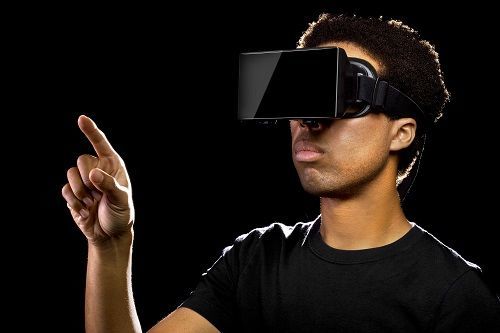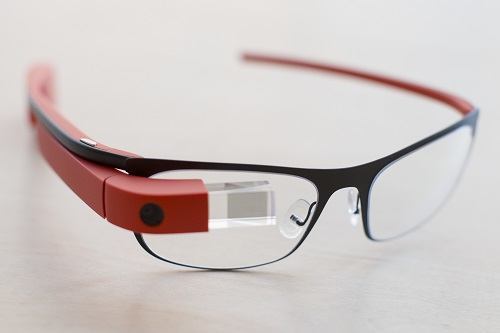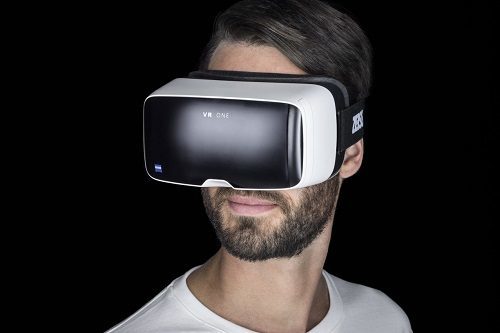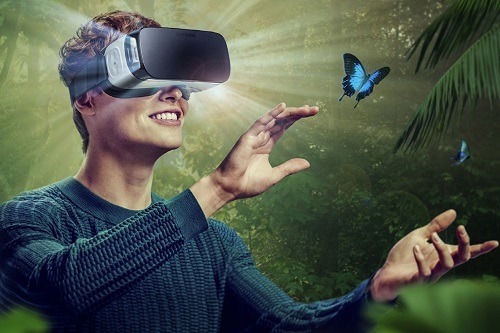Virtual Reality Gadgets
When people think of virtual reality their first thoughts are often of a futuristic user standing with high-tech goggles on their head, reaching around a virtual world. However, virtual reality gadgets extend far beyond these science fiction notions of headsets to encompass a whole range of devices.
Since the first head mounted display was produced in the 1960s, virtual reality gadgets have attempted many times to become a mainstream form of entertainment. However, many failed attempts at these devices have left the public sometimes feeling underwhelmed with the technology.

With constant improvements by researchers and developers in virtual reality, the gadgets that we see will improve and inspire. Current gadgets such as VR glasses, helmets, gloves, and keyboards are just a few of the ways which gamers can immerse themselves in their simulated environments, a far cry from these early models.
However, with all of the advancements, the future of virtual reality gadgets may be in question. As developers look for ways to use the human brain as a controller in virtual worlds, we may see a decrease in the gadgets needed to interact in these simulated environments.
Early VR Gadgets
With most computerised gadgets, their capabilities continue to grow while their size usually shrinks. This is the case with many items we use daily, such as computers and cell phones, which both started out a lot larger than the models we know today.
The same can be said for early virtual reality gadgets, particularly the virtual reality headset. The very first head mounted display that used a computer connection was titled the Sword of Damocles, for the very reason that it had to be lowered onto the user’s head from a ceiling suspension. Invented in 1966, this device was very primitive in terms of capabilities but nonetheless it sparked interest in virtual headsets.
Virtual gaming glasses that were found in arcades in the 90s were also quite large in size and usually relied on the user to sit in a large device to play. This type of gaming helmet model overshadows the small style of virtual headset we use today, such as the Google Cardboard, which can fit easily in the palm of your hand.
Some other popular VR gadgets which attempted to bring this type of technology into the mainstream include:
Sega VR
One of the first attempts at a virtual reality helmet for gamers at home, Sega announced plans to launch their own VR system in 1991. Although launched successfully in arcades a couple of years later, the home version never eventuated.
This system relied on an LCD screen and stereo speakers worn on a visor which allowed the user to play at least four games which were to be released with the system. However, reported side effects to testers meant that the device was never launched to the public.

Nintendo Virtual Boy
Released in 1995, Nintendo’s Virtual Boy was hyped to be one of the biggest VR gadgets to ever hit the mainstream. Advertised as a revolutionary product, this gaming helmet was one of the few times that gaming giants Nintendo appear to have gotten it wrong.
The Virtual Boy featured a monochromatic helmet which displayed the games in 3D mode. However, the quality of images wasn’t enough to satisfy the public and a lack of titles available meant that this system was discontinued the following year.
3D TV
In 2010, there was much hype surrounding the launch of digital televisions which would broadcast images in 3D. These gadgets followed the limited success of 3D films at the cinemas and hoped to transfer this interest to the home user. Broadcasters also wanted to get involved, with the promise of sporting games and other events to be displayed in 3D.
Users would be required to wear a pair of 3D glasses when watching their TV, making the novelty quick to disappear. Eventually, a lack of interest from the public marked the end of this product. There are still some 3D-capable televisions available to purchase, but the smart TV 2D device has been far more successful.
Google Glass
Although not entirely the same as the other virtual reality helmets, Google Glass was another failed attempt to bring this technology to the public. Similar to the launch of Google Cardboard, this gadget attempted to give users a taste of virtual realities and high-end electronics that allow you to switch technologies with voice control.
Unlike Cardboard, though, Google Glass was priced at around $1,500 for a glorified pair of voice activated glasses. It was out of reach for most consumers and overhyped for those who could afford it. However, Google has promised that their Glass gadget is still being improved with a new generation set to launch in the future.
While early VR gadgets are thought to be basic and primitive, without them we wouldn’t have the models for which our electronics are based on today. Developers and researchers can learn from the failed aspects of these products to improve on new ideas so that one day virtual reality for the mainstream is a possibility.

VR Gloves
Virtual reality gloves have always been a popular gadget in this area, dating back to the first instance in 1977 with the Sayre Glove which marked one of the first instances of gesture recognition. Wired gloves or data gloves, as they’re commonly known, have long been a companion to virtual gamers as they allow them to incorporate their own movements within the game.
From their initial invention, VR gloves have made significant advancements. In 1989, Nintendo released the Power Glove which was a bulky device complete with buttons and sensors. Although it had great initial hype, the gadget failed to sell as it wasn’t packaged with a game and the controls were difficult to use and imprecise.
Following this failed attempt, there have been many variations to wired gloves, until modern times when the technology has advanced enough to create a truly immersive experience.
One of the most hyped gadgets in this area is the Manus VR gloves, launching around September 2016. Currently, the gloves work with HTC Vive only but are set to be compatible with both Oculus Rift and PlayStation 4 VR eventually.
Where they differ from the current tools already available are that they allow you real hand presence within a simulated environment, without needing to hold a bulky gamepad or controller. By using just your hands to control your environment, these VR gloves will allow for greater immersion.
The technology behind wired or VR gloves differs for each product, but the three main approaches are:
Fibre Optic
Fingers are measured using fibre optic cables located in the glove. As light passes through the cables to a sensor the computer reads the amount of light to determine where the user’s fingers are. To work correctly, these gloves should be calibrated to the specific player before use.
Electrically Conductive Ink
The glove’s material is coated with electrically conductive ink which senses the user’s hand and finger positions. As the gamer moves, the resistance changes and allows the CPU to respond. Although less expensive than other modes, it’s also the least effective.

Dextrous Hand Master (DHM)
By far the most advanced science behind VR gloves is DHM. This accurate glove has sensors for each finger which attach to your own joints as links. Although they can be bulky, they act as an exoskeleton for the user and provide accuracy and precision.
VR Keyboard
When discussing keyboards in the realm of virtual reality, there are a few different devices available. One is a virtual keyboard that exists only in the simulated environment and is still a work in progress for some developers. The other, a virtual keyboard that is beamed onto the user’s desk in the real world which allows them to type through optical recognition.
The new innovations of virtual keyboards will one day allow gamers to type on a device that appears in their simulated environment. While there are currently some applications available for download to use with Oculus Rift, the technology still isn’t precise enough to allow for correct use.
The laser virtual keyboards which beam the image of a keyboard onto your desk or workspace are connected to your phone or computer through an app. The user types on this projected image of a keyboard and using optical recognition, the software translates the keystrokes to the document or other application on your device.
Developing virtual reality keyboards further will be extremely important to this technology if it’s to one day become more than just an entertainment device. As employees may one day work with simulated environments and students learn from virtual classrooms, creating equipment that works as well as their real-world counterparts are crucial.
VR Glasses
With so many expensive devices now on the market, basic VR glasses have seen an increase in popularity too. Without needing any technical cables or electronics, these gadgets are changing the way we access simulated worlds.
The most popular form of VR glasses would be Google Cardboard, which is constructed from basic cardboard to form a viewer that connects to your smartphone. The key to these glasses is that all of the technology comes from your phone, where the glasses are simply a way to view it.

Google announced plans for the Cardboard 3D VR glasses at their developers’ conference in 2014 as a way for the public to experiment and create with virtual reality. Not only is there an app which allows for virtual viewing of movies and games, but also a development kit which encourages users to create their own shareable content.
True to Google’s form, this invention has been an affordable and effective way for people to witness virtual reality without having to spend hundreds on expensive devices. Never intended to be a huge profit maker for the company, it was more about sparking discussion and innovation from users.
As of January 2016, over 5 million Cardboard viewers have been sold. Retailing at under $20, Google Cardboard and its many virtual reality glasses variations are effectively cheap and easy to use. However, to experience this amazing technology at home for there is a way to make your own virtual reality goggles.
Materials
- A piece of cardboard at least 22 x 8.75” (pizza box cardboard is ideal)
- Two strips of wide Velcro
- A neodymium ring magnet
- A ceramic disk magnet
- Two Biconvex lenses (45mm focal length)
- Rubber band (optional, to connect to your head)
- NFC tag (optional, allows for wireless data transfers)
- Download the manufacturer’s kit from the Google website and print the required three pages.
- Cut around the templates, removing any excess paper until you’re left with the shapes for the design. Align the corresponding pieces together so that you have three separate piles for the lens holder, lens divider, and the body.
- Using these shapes as your guide, cut out the cardboard so that it corresponds with the templates. Spray the cardboard with an adhesive and let it sit for a few minutes before pressing the cardboard templates into place.
- Perform all of the smaller cuts with a knife, taking the time to ensure you follow the templates exactly, leaving the round and more intricate pieces until last.
- Insert your lenses into the eye holes, following the template’s instructions on which direction to place them in. Fold the top third of the lens holder down and the bottom third up which will hold it into place.

- Next, put the ceramic magnet in its place and then the neodymium magnet on the opposite end.
- Insert the lens holder into the divider and place the cardboard around it so that it holds into place. Ensure that you’ve lined up all of the grooves correctly before gluing it down.
- Grab the Velcro strips and glue them to the top of the flap where your phone will go.
- If you’ve chosen to add an NFC tag, you can now attach this to the glasses. You’ll need to also program it correctly so that it connects with your Cardboard.
- For those who want to have a hands-free VR experience, cut your rubber band in one spot and stretch it over the back of the Cardboard. Staple each end down carefully to create a headband.
- Download the Cardboard app with your smartphone and launch it, then slide your device into the newly made goggles. Enjoy!
VR Headset
Virtual reality headsets could describe a number of devices, however, it mainly relates to complete sets that offer both audio and visual immersion. The basic VR helmet works by using two separate screens, one for each eye, and displaying a different version of an image on each screen. This picture is constantly reshaped and focused using special lenses within the headset to create a stereoscopic 3D image.
Two of the most popular VR headset systems released in 2016 were the Oculus Rift and HTC Vive. Both allow for full immersion with visuals and audio projected into the headset and offer a variety of games and movies to keep users entertained.
The Oculus Rift headset has also been fitted with sensors that monitor the user’s head motions and adjust the image as you move, newer models even have an external position tracker so that these movements can be followed more precisely. These head sensors allow for a more realistic experience and also help to combat dizziness.
The HTC Vive goes one step further and allows for room-scale VR experiences, thanks to the use of special sensors. These sensors mean that gamers can utilise the entire space in their lounge room with their movements emulated in the virtual world.
Many argue about which is the best virtual reality headset, but it seems to be a close tie. With new contenders such as PlayStation 4 VR arriving later in 2016, though, there is always plenty of new competition to be found.

The Future of VR Gadgets
As advancements are made in the field of virtual reality, will we see these gadgets get smaller or perhaps become obsolete altogether? If history is anything to go by, we’re sure to see the bulky gadgets replaced with sleeker and more futuristic models, each with increased capabilities. Beyond these advancements, though, what else is possible in the future of virtual reality?
Using your mind to control a simulated environment, or neuro gaming is set to be the next big thing for virtual reality. If this is the case, VR gadgets may become a thing of the past. At a Neuro Gaming expo in 2015, many researchers discussed the possibility of this type of control and stated that it wasn’t too far off.
The thought that you could ditch your VR helmet and gloves is a futuristic one, but not completely irrational. Neuro gaming works by using brain-computer interfaces which allow users to interact with a game without any controllers and is already used in some professions.

Current applications of neuro gaming technology are seen in the health fields to treat patients with PTSD, ADHD, and other disorders of the brain. However, something with this much potential to change the world of virtual reality is not without concerns. Figuring out how to prevent things such as mind control, mind reading, and brain intrusion may seem futuristic and paranoid, but all are very real possibilities.
Will too much immersion make it difficult for people to disconnect the virtual world from their own? Research published in The Atlantic has shown that some users may find it hard to take a break from virtual entertainment, eventually finding it so satisfying of their social needs that they no longer want to connect in the real world.
If VR gadgets progress to the point that Mark Zuckerberg hopes for with his Oculus Rift, virtual reality may become a way to visit health professionals, see sports games, or even learn in a classroom. With simulated environments replacing so much of what we do in reality, there is the potential for issues.
This type of concern is nothing new, however, and as long as humans have interacted with technology we have realised the effects that escapism can have on our minds and society as a whole. While the uses of VR may grow well beyond entertainment, it will still be years away that these gadgets can have any real effect on our interactions with each other.
How to Buy VR Gadgets
Depending on the style of gaming or VR experience you’re looking for, there could be any number of gadgets to suit. The most popular tool at the moment is the VR headset, as it encompasses many of the other gadgets within the one system.

Before you decide to purchase a virtual reality headset for sale, be sure that you have the correct requirements for the system. Both HTC Vive and Oculus Rift require a computer connection that has minimum software and hardware requirements so do your research before you make your decision.
Some products may not yet be available and others you might even be able to create yourself. Google Cardboard has clear instructions available for users to craft their own virtual viewing device, and some of the more complicated tech sites have guides on how to make your own VR keyboard.
Always keep an eye on virtual reality news, as there’s no telling when the next big product may be launching. As the technology continues to expand and grow, so too does the availability of these amazing gadgets. Where VR was once considered something for only the wealthy to enjoy, it’s now completely accessible to everyday people.


